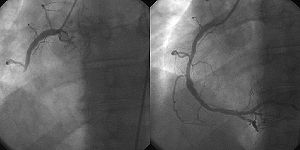Interventional cardiology

Interventional cardiology is a branch of
Many procedures can be performed on the
The main advantages of using the interventional cardiology or radiology approach are the avoidance of the scars and pain, and long post-operative recovery. Additionally, interventional cardiology procedure of primary angioplasty is now the gold standard of care for an acute myocardial infarction. It involves the extraction of clots from occluded coronary arteries and deployment of stents and balloons through a small hole made in a major artery, which has given it the name "pin-hole surgery" (as opposed to "key-hole surgery").
Procedures
- Angioplasty
- is an intervention to dilate either arteries or veins.
- Percutaneous coronary intervention (PCI/Coronary angioplasty)
- heart attack, it can be restricted to the culprit vessel (the one whose obstruction or thrombosis is suspected of causing the event) or complete revascularization; complete revascularization is more efficacious in terms of major adverse cardiac events and all-cause mortality.[4]
- PCI is also used in people after other forms of myocardial infarction or
- Valvuloplasty
- It is the dilation of narrowed cardiac valves (usually mitral, aortic, or pulmonary).
- Congenital heart defect correction
- Percutaneous approaches can be employed to correct atrial septal and ventricular septal defects, closure of a patent ductus arteriosus, and angioplasty of the great vessels.
- Percutaneous valve replacement
- An alternative to percutaneous aortic valve replacement/TAVI procedure), pulmonary valve and recently the mitral valve
- Percutaneous valve repair
- An alternative to open heart surgery, percutaneous valve repair is performed on the mitral valve using the MONARC system or MitraClip system[7]
- Coronary thrombectomy
- Coronary thrombectomy involves the removal of a thrombus (blood clot) from the coronary arteries.[8]
Open heart surgery of the heart is performed by a cardiothoracic surgeon. Some interventional cardiology procedures are performed in conjunction with a cardiothoracic surgeon.
Education
In the US and Canada, interventional cardiology requires a minimum of seven years of post-graduate medical education and up to 9 years of post-graduate medical education for those wanting to perform advanced structural heart procedures.
- Undergraduate degree (4 years)
- Medical degree (4 years)
- Internal Medicine residency (3 years)
- Cardiology fellowship (3 years)
- Interventional Cardiology fellowship (1–2 years)
- Structural Heart Intervention fellowship (1 year)
See also
References
- PMID 19740425.
- ^ "Interventional Cardiology Specialty Description". American Medical Association.
- ISBN 0-07-142264-1.
- PMID 28647440.
- S2CID 256699436.
- PMID 22872053.
- PMID 21251638.
- ^ "Evanston Northwestern Hospital Interventional Cardiology". Retrieved 2008-03-06.
